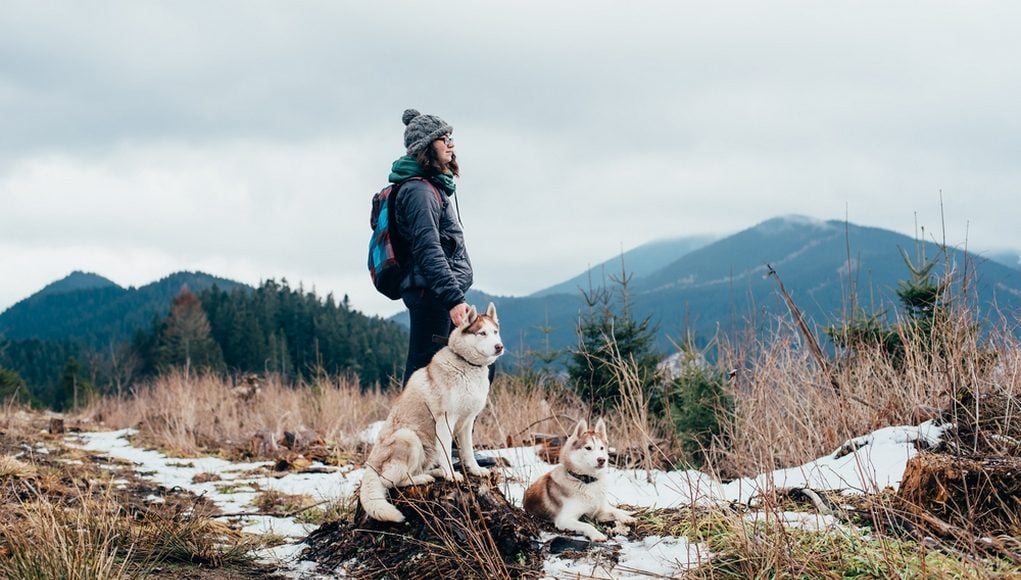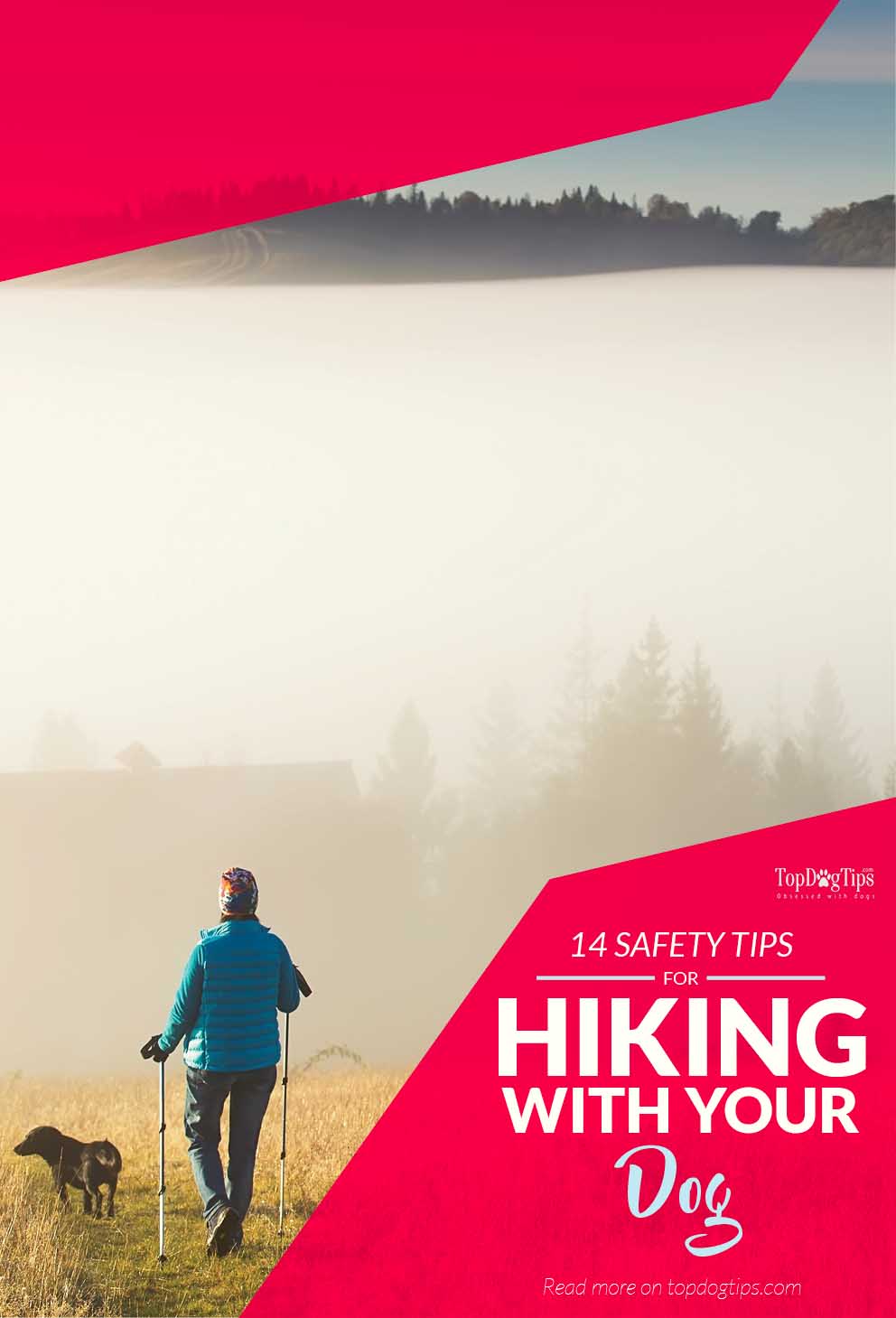Chances are you love the great outdoors as much as we do and you want to take your companion along for the adventure. There are lots of great dog-friendly trails out in the open country with scenic views, but when not being careful, your canine may run into trouble. There's a risk of disease, injury, illness or even the dog getting lost whilst on an instinctive scavenger hunt.
Following a few simple tips and tricks will keep you both safe while exploring your local forest or hiking on designated trails. Just be sure to have a quick chat with your vet if this is your pet's first time out. You want to be certain that he's healthy enough to withstand the strain of a hiking trip.
RELATED: Dog Hiking Gear Guide – 13 Items You Need for Hiking With Dogs
14 Tips and Tricks for Hiking With Your Dog
1. Find a trail that’s dog-friendly
Not all paths are suitable for taking your dog along. You should avoid tracks that have any sharp rocks or a steep slope, more so those frequented by mountain bikers or horses. These tracks have a rough terrain that may not agree with your dog’s soft paws.
If you don’t particularly have a place in mind, you could easily find one according to your state over at HikeWithYourDog. You can search for dog-friendly hiking trails in your area and find detailed information about any trail that you're not familiar with.
2. Make sure he’s ready for a trek
It really isn’t a good idea to take a puppy out into the hills unless you’re prepared to carry him the whole time. If your dog is too young to make the trek, think about investing in a backpack carrier if you're still interested in bringing him along with you.
On the other hand, if he’s old enough, don’t expressly take him out on an ultra-long trip all at once. Condition him by getting him used to the outdoors to harden his paws. If you have a senior dog, keep the hike short and be sure that he's fit enough to make the journey.
3. Take some health precautions
Before you go out, ensure your dog is up to date with his vaccines since rabies and distemper are out there lurking. Although not as common as they once were, they are still dangerous and very real. Going for a check-up at your vet's would be a great idea, especially for the very first time you're going hiking with a dog.
4. Pack a first aid kit
Make sure you also pack up a doggy first aid kit that should at least include tweezers, bandages, and gauze. Before you go out for your trek, ensure your dog does not have any open wounds that would fall victim to the elements or infection.
Out there, anything could happen, and if whatever that happens to be is an injury, you’re going to want to be prepared to deal with it. Some common incidences include getting pricked by thorns, bleeding foot pads and cuts from animal bites.
 Your dog first aid kit should contain:
Your dog first aid kit should contain:
- Betadine or hydrogen peroxide
- Bandages
- Tweezers
- Aspirin for pain
- Topical antibiotics
- Benadryl for allergies
5. Keep him on a leash or harness
Keep him on a leash at all possible times and ensure he doesn’t pull or tug on the leash. This can be easily accomplished with prior training. Don’t use a retractable leash. These are convenient for everyday use, but tend to be more of a hassle when on an open trail.
You also need to outfit your dog with a harness. Harnesses provide more control over the dog than a standard collar. They are also more comfortable for long leash walks.
6. Make sure he’s properly trained
Fido should be able to respond to basic commands such as come and stay.
You could also teach him an emergency recall command that would ensure he drops anything he was doing at the time and runs back to you immediately. This is especially useful if he wanders off for too long and you get worried about him.
7. Ensure you have enough food and water
How much food and water depends on various things, including how much you and your dog eat, the weather, the area you plan on visiting and how long you intend to stay.
Estimate how much you will need before setting off, and then pack a little extra just to be safe. Dog water bottles are convenient for these types of trips with pets, and if you think your hiking venture will take longer, travel bowls are yet another option to consider.
8. Watch what your dog eats
 You shouldn’t let him just eat up anything he finds out in the wild, because he could easily get into something poisonous or toxic. He could also drink up bacteria from an infected stream or pool of water.
You shouldn’t let him just eat up anything he finds out in the wild, because he could easily get into something poisonous or toxic. He could also drink up bacteria from an infected stream or pool of water.
It’s for this reason that you should ensure you bring along lots of water for yourself and water for your dog in water bottles before you go out for your trek. At this point, commands such as ‘leave it’ would definitely come in handy as well. Don't be like the owner of this dog that died on a hike because the owner allowed him to eat some plants.
RELATED: A Basic Safety Guide to Hiking with Dogs
9. Watch out for other animals
Suppose your dog sees or hears a rabbit running around in the horizon, his instincts will kick in and he’ll try to chase after his potential prey. This could lead him to more danger and worse still, he may get lost.
10. Check the weather forecast
As boring as this sounds, it really helps when you can predict the weather pattern in hours to come. Snow can be dealt with using a simple sweater, but the heat and rain are more challenging.
There’s not much you can do if the rain catches you off-guard. All I do to counter this is to use a doggy towel and dry him up before we get back into the tent. Dogs can get hypothermia too, so play safe.
Hot weather is the hardest to deal with. While going for your trek, take it slow, take a break and rest off in the shade every once in a while and above all – stay hydrated.
 Watch out for warning signs like:
Watch out for warning signs like:
- Refusing to move
- Drooling
- A red tongue
- Pale gums
- Thick, sticky saliva
- Fatigue
- Excessive panting, typically with the tongue out on the side
If you observe one or multiple of these symptoms – take a break and give your dog some water right away.
11. Stay on the trail
Getting lost is much easier than it seems by choosing to adventure in all the wrong places. If there is a trail, it’s probably there for a reason – to help you find your way through the safest route possible.
12. Invest in a quality dog backpack
There's a number of hiking supplies you'll need, and it's a good idea for your dog to carry his own luggage since you’ll have too much on your hands as it is. This also requires some training before being able to shove off. It should also be done with consideration of Fido's size –typically not more than 10 -20% his body weight.
 The doggy saddle backpack should be, at the very least, weather-resistant and should fit snugly to avoid damaging the spine. Ensure the weight is centered on the shoulders, not the back.
The doggy saddle backpack should be, at the very least, weather-resistant and should fit snugly to avoid damaging the spine. Ensure the weight is centered on the shoulders, not the back.
13. Get him checked up
Going out for a little hike once in a while is a good idea, but could end up pretty disastrous if you don’t take necessary precautions after going out. If he happened to drink water from a suspicious pond, wandered off for extensive periods or he shows signs of illness after the walk, take him to a vet right away to have him checked up.
14. Have fun!
Don’t forget the point of going out there was to be free from the daily labors of everyday life. Don’t be too worried about your dog to have a good time. Don’t smother him too much, and give him time to sniff around and explore.
READ NEXT: Camping With Dogs? Tips, Guidelines, Do’s And Don’ts















